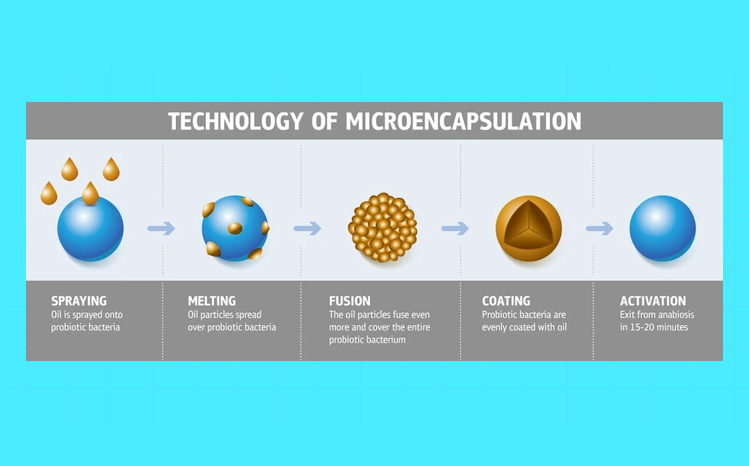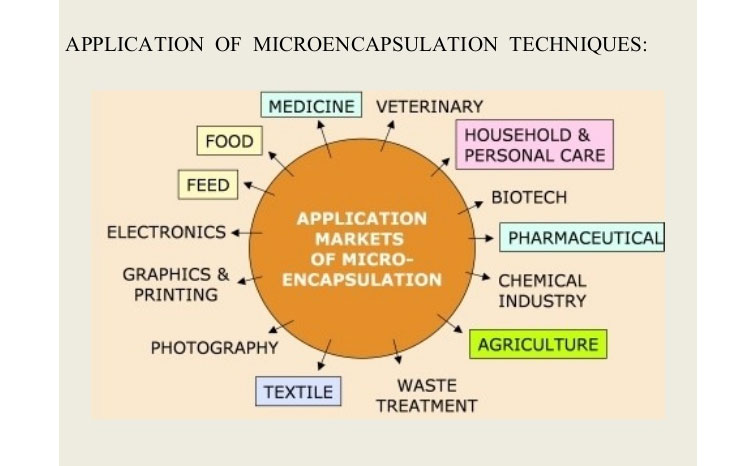

Features
Reduce Overages
Protection & Precision
Release Parameters
Flavor and Odor Masking
Effectiveness & Ease of Handling
Advantages of Microencapsulation
 Protection of active from degradation
Protection of active from degradation Reduce evaporative loss
Reduce evaporative loss Shelf life enhancement
Shelf life enhancement Handling liquids as solid
Handling liquids as solid Handling of toxic materials in safe and convenient way
Handling of toxic materials in safe and convenient way Masking of odor and taste
Masking of odor and taste Immobilization of enzymes and microorganisms
Immobilization of enzymes and microorganisms Sustained, controlled and targeted delivery or timed release
Sustained, controlled and targeted delivery or timed release Better processability (improving solubility, dispersability, flowabilty)
Better processability (improving solubility, dispersability, flowabilty) Reduce plant stress and phytotoxicity
Reduce plant stress and phytotoxicity Reduce pesticide level in ground water
Reduce pesticide level in ground water Improve product utility
Improve product utility Easier to use
Easier to use Application flexibility
Application flexibility Lower use rate
Lower use rate Enhanced performance
Enhanced performance
Microencapsulation is defined as a technology of packaging solids, liquids or gases, obtaining as a result thereof tiny particles or droplets surrounded by a coating, called microcapsules. In a relatively simple form, a microcapsule is a small sphere or fiber of an active substance container (diameters are between a few micrometers and a few millimeters) with an uniform, micro-porous and semi-permeable wall around it. The material inside the microcapsule is referred to as the core, internal phase, or fill, whereas the wall is sometimes called a shell, coating, or membrane. These microcapsules are inserted into final products to get the added-value that makes the difference respect to the competence. Thanks to the microencapsulation, several developments are getting to enhance products that are now already fully developed but currently require improves that the microencapsulation can provide.
Microencapsulation is defined as a technology of packaging solids, liquids or gases, obtaining as a result thereof tiny particles or droplets surrounded by a coating, called microcapsules. In a relatively simple form, a microcapsule is a small sphere or fiber of an active substance container (diameters are between a few micrometers and a few millimeters) with an uniform, micro-porous and semi-permeable wall around it. The material inside the microcapsule is referred to as the core, internal phase, or fill, whereas the wall is sometimes called a shell, coating, or membrane. These microcapsules are inserted into final products to get the added-value that makes the difference respect to the competence. Thanks to the microencapsulation, several developments are getting to enhance products that are now already fully developed but currently require improves that the microencapsulation can provide.
The reasons for microencapsulation are countless. It is mainly used to increase the stability and life of the product being encapsulated, facilitate the manipulation of the product and control its liberation in an adequate time and space. In some cases, the core must be isolated from its surroundings, as in isolating vitamins from the deteriorating effects of oxygen, retarding evaporation of a volatile core, improving the handling properties of a sticky material, or isolating a reactive core from chemical attack. In other cases, the objective is not to isolate the core completely but to control the rate at which it leaves the microcapsule, as in the controlled release of drugs or pesticides.
The definition has been expanded, and includes most foods, where the encapsulation of flavors is the most common. The technique of microencapsulation depends on the physical and chemical properties of the material to be encapsulated.
